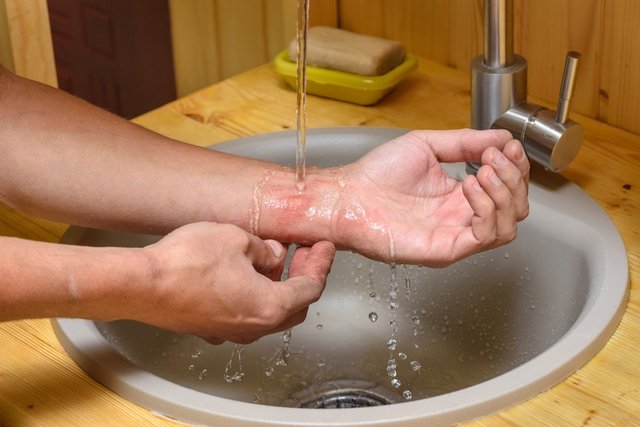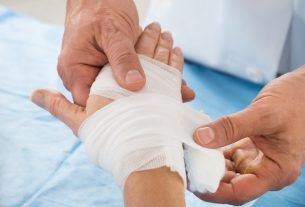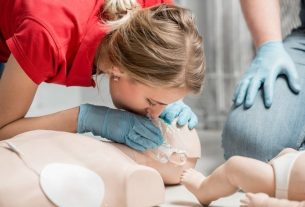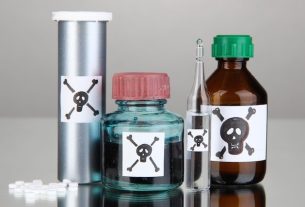In case of a lemon burn, you should place the burned part of the skin under cold running water for about 10 minutes, and then it is important to consult a dermatologist or go to the nearest emergency room so that the area can be treated. best rated.
Lemon burn, called phytophotodermatitis, occurs due to the presence of furanocoumarins in lemon, such as psoralen, which are absorbed by the skin and react with the sun’s UV rays, causing an allergic reaction in the skin.
The type of lemon burn varies with the amount of furanocoumarins absorbed from the skin, the extent of the affected skin and the time of exposure to the sun, with 1st, 2nd and 3rd degree burns possible.

First aid for lemon stain
In general, for 1st, 2nd or 3rd degree burns caused by lemon, you must:
- Rinse the affected skin in cold running water for 10 to 20 minutes;
- Remove personal items immediatelysuch as rings, watches, bracelets, necklaces, glasses, clothes, shoes or belts, which vary depending on the affected region;
- Apply cold compresses with 0.9% saline solution in the first 24 hoursapply a soothing cream and consult a dermatologist, in the case of a 1st degree burn;
- Wash the eye area thoroughly under cold running water or with 0.9% saline solution.if the burn occurred in or near the eyes, and go to an ophthalmologist immediately.
In cases of 2nd and 3rd degree burns, where intense burning, redness, swelling or blistering occurs, you should go to the emergency room immediately. Know how to recognize 2nd and 3rd degree burns.
What not to do
Some measures that you should not take when you have a lemon burn are:
- Do not apply ice to the affected skin;
- Do not apply alcohol, coffee grounds, toothpaste or sugar;
- Do not apply oily products, such as olive oil, butter, oils or oily ointments;
- Do not touch the location;
- Do not try to remove fabrics stuck to the burned skin;
- Do not remove detached layers of skin
Furthermore, you should never burst a burn blister, as it increases the risk of infections, which can worsen recovery and even affect healing, making antibiotic treatment necessary. If necessary, the blister should only be drained in the hospital, by the doctor, using sterilized material.
How to Prevent Lemon Burn
Lemon burn is very common in the summer, due to the preparation of juices, caipirinha or even to season food, for example.
To prevent this type of burn, you must immediately wash your hands or any part of your skin that has come into contact with the lemon, using water and neutral soap. It is also important to wash your face and mouth well after drinking drinks with lemon.
Afterwards, you should apply sunscreen liberally and reapply whenever you enter the water or sweat. Furthermore, preferably, direct sun exposure should be avoided, covering the skin area or staying in the shade, for example. See also how to remove lemon stains from your skin.
When to go to the emergency room
You should go to the emergency room immediately in the following situations:
- Burn greater than the size of the palm of 1 hand;
- Burns on the face, lips, palms or wrists;
- Redness or swelling that worsens over time;
- Very intense pain or burning in the area;
- Bubbles appear;
- Open wounds on the skin;
- Fever.
In addition, you should also go to the emergency room immediately if the person has swelling in the face, mouth or throat.
In the case of babies, children and the elderly, any type of burn needs to be evaluated by a doctor, so they should be taken to the emergency room immediately.
Bibliography
- MIODUSZEWSKI, M.; BEECKER, J. Phytophotodermatitis from making sangria: a phototoxic reaction to lime and lemon juice. CMJ. 187. 10; 756, 2015
- MINISTRY OF HEALTH. Burns. 2004. Available at: <https://bvsms.saude.gov.br/bvs/dicas/54queimaduras.html>. Accessed on 01 Sep 2023
- MINISTRY OF HEALTH. Manual for emergency treatment of burns. 2012. Available at: <https://bvsms.saude.gov.br/bvs/publicacoes/cartilha_tratamento_emergencia_queimaduras.pdf>. Accessed on 01 Sep 2023
- SARHANE, KA; et al. Phytophotodermatitis. Eplasty. 13. ic57, 2013

Sign up for our newsletter and stay up to date with exclusive news
that can transform your routine!
Warning: Undefined array key "title" in /home/storelat/public_html/wp-content/plugins/link-whisper-premium/templates/frontend/related-posts.php on line 12
Warning: Undefined array key "title_tag" in /home/storelat/public_html/wp-content/plugins/link-whisper-premium/templates/frontend/related-posts.php on line 13



